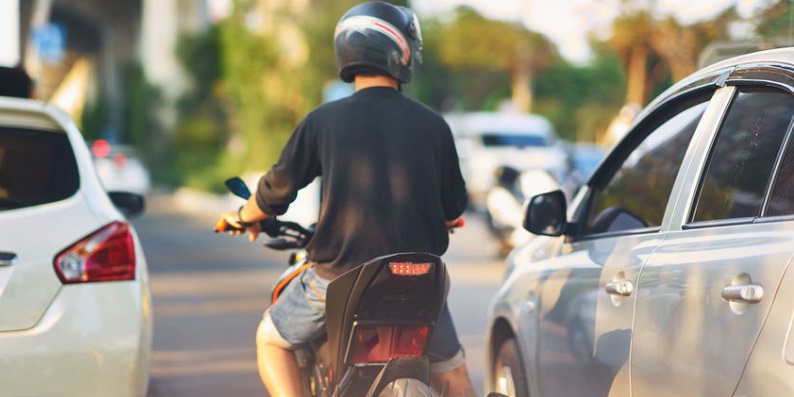Passing or overtaking a vehicle in the same lane is illegal in Colorado, and lane sharing or splitting is also prohibited.
Motorcyclists Face Heavy Price for Saving Time in Traffic
A little over a month ago, a Colorado motorcyclist and his passenger died after lane splitting on Woodmen Road in Colorado Springs. The driver reportedly was speeding through the lanes before being struck by a Jeep that was turning left.
What is lane splitting?
Lane splitting, also known as “filtering,” “white-lining,” “stripe-riding,” or “lane sharing,” occurs when a motorcyclist cuts in between lanes of slow-moving or stopped traffic to maneuver through traffic congestion.
Although lane splitting is common in many countries, it is considered dangerous in the U.S., where it is specifically allowed by law in only one state: California. The other states either prohibit the practice or leave it up to police officers to determine whether it is being done recklessly. According to Colorado law, passing or overtaking a vehicle in the same lane is illegal, and lane sharing or splitting is also prohibited. However, motorcycles are permitted to share a lane, or “co-ride,” with another motorcycle.
Why do motorcyclists split lanes?
Despite widespread legal restrictions, lane splitting is relatively common among motorcyclists who want to save time and avoid traffic congestion, particularly in large cities. Some proponents of the practice say it removes motorcycles from behind stopped cars, where they can be hit from behind. They point out that lane splitting is safer than sitting in traffic because it allows motorcyclists to ride in a safer position: between two larger vehicles.
Several years ago, researchers from the University of California, Berkley performed a study on the safety of lane splitting. After reviewing approximately 6,000 motorcycle accidents, the researchers found that many of the riders were hit from behind by inattentive drivers while sitting in traffic. The study concluded that lane splitting can be reasonably safe in traffic moving at 50 mph or less, and if motorcycles are not traveling more than 15 mph faster than other vehicles. Above the 15-mph differential, the risk of injury rose dramatically, the researchers found.
What makes lane splitting dangerous?
The following scenarios illustrate how motorcycle accidents arise following the dangerous practice of lane splitting:
- A motorcyclist is riding between two lanes of moving traffic when a motorist unexpectedly switches lanes and crashes into the rider.
- A motorcyclist is injured when a passenger opens a door to exit a vehicle and strikes a motorcyclist riding between two lanes of traffic.
- A motorcyclist stops on the passenger side of a vehicle in the driver’s blind spot and is struck at an intersection when the driver attempts to turn right.
Motorcyclists who are citing for lane splitting in the state can be fined anywhere from $15 to $100, and points can be put on their driving record.
Will lane splitting ever become legal in Colorado?
Whether or not lane splitting will be permitted in Colorado is difficult to predict. In 2016, Colorado lawmakers proposed a bill to make the practice legal in the state, in limited situations. The bill would have permitted motorcyclists in slow traffic (moving 5 mph or less) to travel forward in the space between two lanes of vehicles. The measure was struck down by a Colorado House committee with an 8-5 vote.

